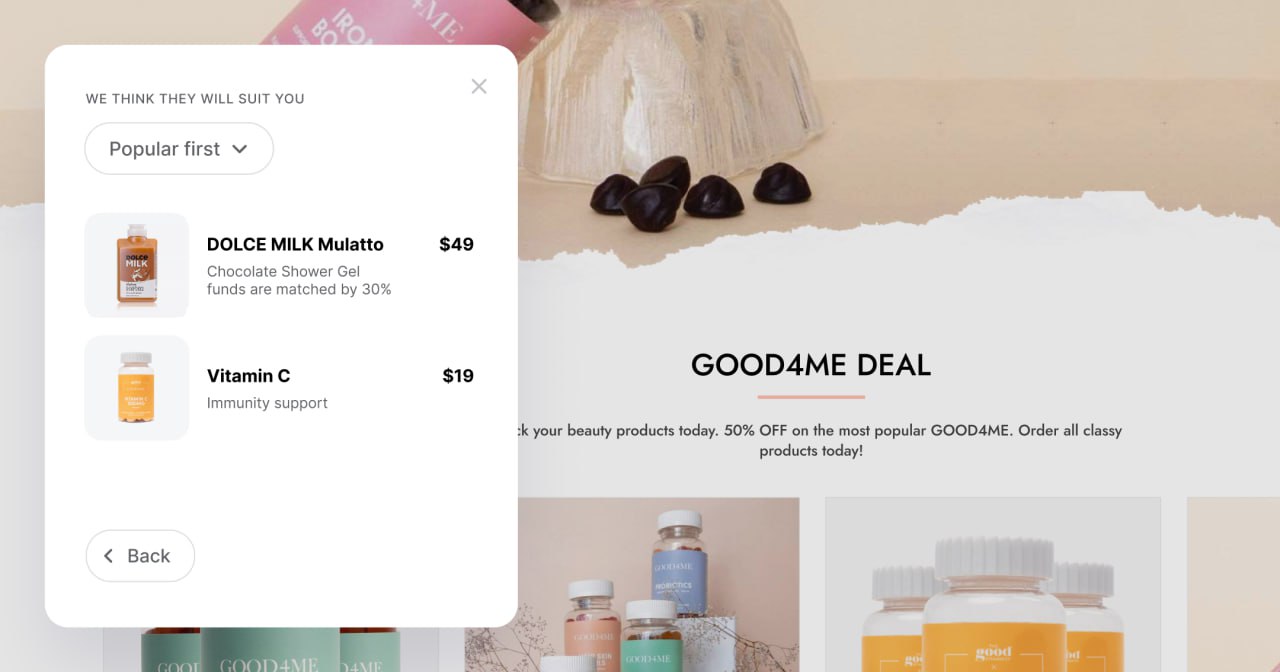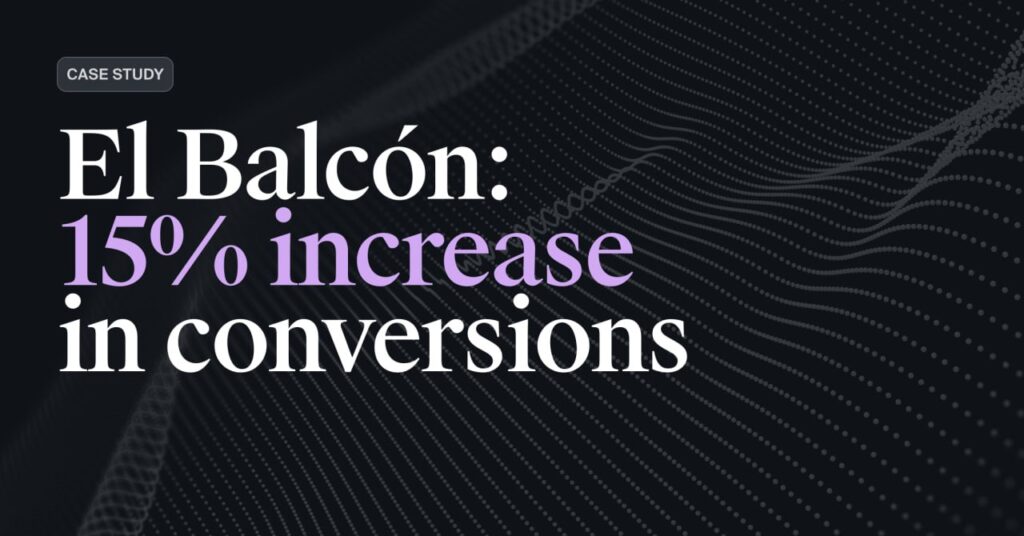
Is your e-commerce website using any product recommendation tools? If not, you’re unfortunately leaving lots of cash on the table. Nowadays, product recommendation tools are one of the most common and effective tactics online retailers use to deliver relevant customer experience and drive sales. Research from Salesforce shows that personalized recommendations drive 26% of the total revenue of an ecommerce business.
However, many businesses still need to implement this sort of tool on their website. Or they have, but it isn’t working as it should. Truth is, the ecommerce world is changing by the minute, as well as all the apps it comes with. It’s almost impossible to catch up on everything you need to do to keep your business competitive. At times, it may feel like a massively overwhelming task. But a few factors make us believe product recommendations are a priority when it comes to ecommerce business. And more importantly: implementing this tool on your site can take you less than a couple of hours.
Before we get deeper into the topic, let’s establish what product recommendation tools are, how they work, how to use them for your business, and finally, why they’re vital for an online store.
Table of Contents
What are product recommendations?
Walking into a big store and trying to find what you want is always problematic. Sometimes, you know you need something to solve a problem, but you don’t know the name of it. If we transfer that to an online store, we have the search bar and categories to get where we want. But if the store offers more than a few products, clients might click around your site for a few minutes without finding what they need. And a few minutes are critical for online sales. The average page visit lasts less than a minute, and users often leave websites in less than 15-20 seconds.
Let’s set an example of a physical store to understand how product recommendations work: you walk into the big store and know you’re looking for “something to clean dry leaves off your patio faster.” So you wander around looking for a store clerk who asks you what you’re looking for. You explain your problem and follow the store clerk to “electric wind blowers.” You will set your budget, and the store employee will signal you to the right product. He will give you a card to show at the register (and probably get a commission for this sale). You pay and, finally, get your new patio gadget in your car to drive back home in excitement.
Product recommendation tools work in a similar way, but in the digital world. Let’s follow the same example. You’re on a home gadget ecommerce website, and type into the search bar “something to clean dry leaves off my patio faster.” And unexpected results come up. With a product recommendation tool, the game changes. When you open the website, a pop-up asks, “What are you looking for today?”. It will display a few store categories, something like “kitchen,” “bedroom,” “patio,” and so on. You will click “patio.” Then, the tool will ask a couple more questions based on previous customer queries and your search history. With three or four questions, it will take you to the right gadgets in minutes. You will enter your address, pay and wait with excitement for the arrival of your new electric wind blower.
As an entrepreneur, this recommendation tool generates sales without taking away a commission. It is also assisting the customer and reducing steps in the buyer journey. In marketing, it’s what we call “reducing friction.” A product recommendation tool makes shopping easier for customers and drives sales for ecommerce merchants.
How AI powers product recommendations
Now that we know what product recommendation tools do, let’s look at how they work. Product recommendation tools use a set of algorithms to show relevant products to your visitors. They do this by using data like location, gender, and purchase intent.
Behind all these capabilities is today’s most talked-about technology: Artificial Intelligence. While many have predicted the apocalypse with the culmination of this type of technology, the truth is that companies that are using it to their favor are making more money. AI powers product recommendation tools by making them learn from other customer’s queries and understanding how clients reach the products they want. It can improve the questions it asks and give better recommendations as time passes. That way, it’s like your new salesperson: it gains experience with time.
The ecommerce giants are using product recommendations
One product recommendation tool most of us know is the one used by Netflix: it explores your taste in movies and TV Shows and gives you a list of recommendations on the platform’s home page. Another famous company using recommendations is Amazon. On every step of the buyer’s journey, it will offer a few suggestions at the bottom.
And if you still think recommendation tools are a bad investment, consider this: 35% of Amazon’s sales come from recommending products to their customers, and 75% of what is watched on Netflix is chosen from recommended titles.
If you’re wondering how this can work for your business, don’t fret. The type of industries that benefit from this tool is not limited to retail and entertainment: product recommendations are so versatile you can use them to recommend anything you want to sell on your website. It’s just a matter of finding the right tool.
Eye-opening stats
Let’s take a look at some stats on how product recommendation tools are transforming ecommerce businesses for the better:
- 54% of retailers claimed that product recommendations are the key driver of customer purchases’ average order value (AOV).
- Around 71% of e-commerce sites offer product recommendations.
- Research from Salesforce shows that shoppers that click on recommendations are 4.5x more likely to add items to their cart and 4.5x more likely to complete the purchase.
- Even shoppers who clicked on a recommendation but didn’t buy had higher engagement rates. These shoppers were 20% more likely to return to the site later.
- 49% of consumers said they had purchased a product they did not initially intend to buy after receiving a personalized recommendation.
How to implement product recommendations for your business
You can use product recommendations on your website in many different ways. For example, your website may have them as pop-ups or banners. Another form is through the marketing emails you send out.
As with any tool, what is good for one business may not necessarily be good for the other. While some product recommendation engines work perfectly across all industries, others are best suited for specific industries.
You can check what other companies are saying about the tool. Before you choose the best tool for your business, make sure it works with the type of services and products you offer. Look around to see what others are using, and ask yourself why.
It’s essential that the tool you choose is easily integrated into your current website. If you don’t have an experienced tech team, it’s better to get a user-friendly recommendation engine that is straight to the point. There’s no need to get sophisticated regarding recommendations: the most important thing is that they are accurate and the product display is clear and intuitive for the buyers.
Website Personalization
Regarding product recommendation engines, Sellesta’s Website Personalization feature offers an excellent option. It has different traits that make it a great fit for any ecommerce business:
- Streamlined product search
Asking a few questions, it helps customers find relevant products quickly. This way, it simplifies the buyer’s journey.
- Non-invasive, tailored recommendations
It provides highly targeted and personalized recommendations for your customer.
- Valuable customer insights
It collects information on potential buyers to help you improve product and marketing strategies.
- Easy integration and fast launch
The Website Personalization widget guarantees seamless functionality, integrating smoothly into any website and content management system.
Benefits of Sellesta’s Website Personalization
How to sell a product that is not getting seen? When you improve the product discoverability for your customers, you are improving conversion. The recommendations display needs to be accurate and non-invasive: no one likes it when salespeople shove products down your throat. And the same happens with a website: suggestions must be on point and pleasant to the eye. This way, you are building trust with your users.
By collecting user data, you tap into a gold mine: nothing is more valuable than getting to know your customers. Just ask Netflix how its annual revenue has grown by 36% each year since its launch in 2001. One of the main factors was implementing a data-driven business plan.
Sellesta’s Website Personalization tool covers all these pains with a simple widget. So, in the end, you save time and money that you would waste on integrating more complex tools.
Modernize or fall behind
We can’t emphasize enough how vital it is to keep up to date with technological advancements —specifically AI— to maintain an ecommerce business. Not taking advantage of product recommendation tools is like leaving your company’s conversion rate to luck.
It’s not about feeling more overwhelmed. The good news is that getting a recommendation tool up and running with your business is not too hard. Yes, it will take some time, and you’ll have to do some research. But you’ll celebrate your effort when you check out the sales for next quarter.If you want to try out Sellesta’s state-of-the-art recommendation engine, you can do it for free today, with no credit card required. Enjoy a boost in sales on your ecommerce website!


